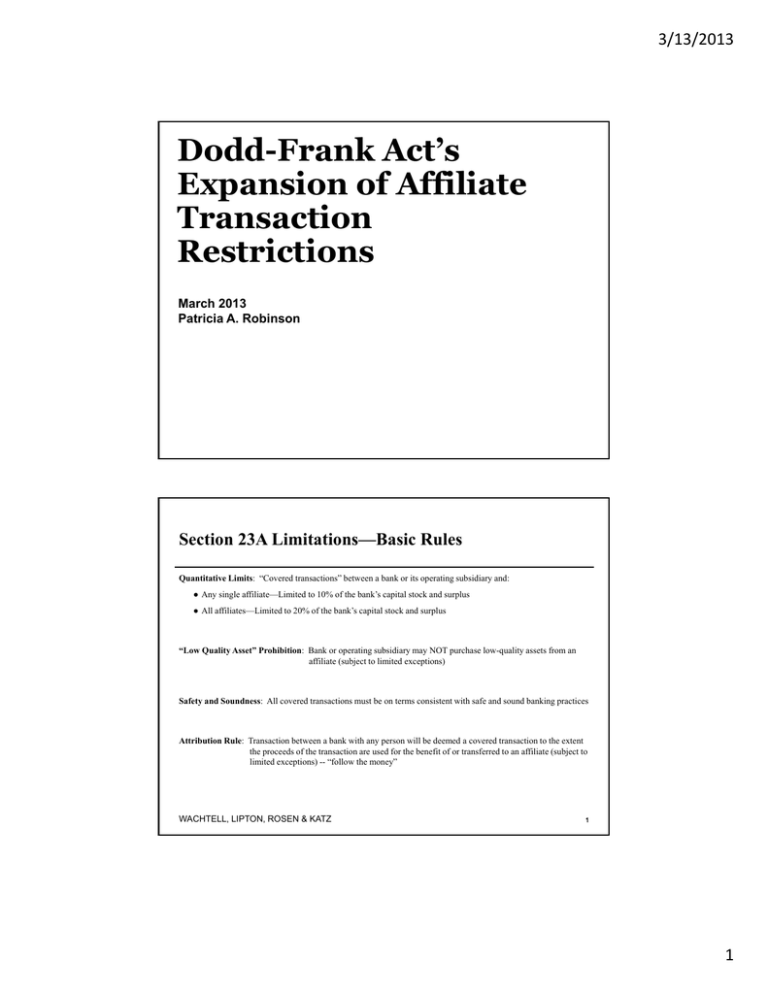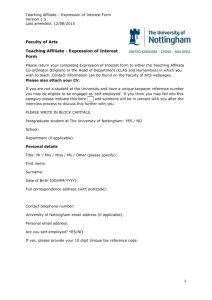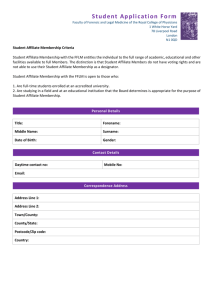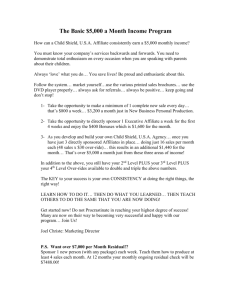Dodd-Frank Act’s Expansion of Affiliate Transaction Restrictions
advertisement

3/13/2013 Dodd-Frank Act’s Expansion of Affiliate Transaction Restrictions March 2013 Patricia A. Robinson Section 23A Limitations—Basic Rules Quantitative Limits: “Covered transactions” between a bank or its operating subsidiary and: ● Any single affiliate—Limited to 10% of the bank’s capital stock and surplus ● All affiliates—Limited to 20% of the bank’s capital stock and surplus “Low Quality Asset” Prohibition: Bank or operating subsidiary may NOT purchase low-quality assets from an affiliate (subject to limited exceptions) Safety and Soundness: All covered transactions must be on terms consistent with safe and sound banking practices Attribution Rule: Transaction between a bank with any person will be deemed a covered transaction to the extent the proceeds of the transaction are used for the benefit of or transferred to an affiliate (subject to limited exceptions) -- “follow the money” WACHTELL, LIPTON, ROSEN & KATZ 1 1 3/13/2013 Section 23A Limitations—Basic Rules (cont’d) Collateral Requirement: Bank must secure its credit transaction with (or on behalf of) an affiliate ● Credit transaction--Loan, line of credit or other credit extension; guarantee, acceptance or letter of credit (issued on behalf of an affiliate); lease (functional equivalent to a financing); advance (overdraft, cash item or otherwise); loan or note purchase; asset purchase subject to a repurchase agreement; credit exposure to an affiliate from a securities lending/borrowing transaction or derivative transaction ● 100-130% of principal amount of the transaction, depending on the quality of the collateral ● Ineligible collateral: o “Low quality asset” – Asset classified as “substandard,” “doubtful” or “loss,” or treated as “other loans especially mentioned” – Non-accrual asset – Assets with payments past due more than 30 days – Assets renegotiated or compromised due to obligor’s deteriorating financial condition – Assets acquired through foreclosure (unless reviewed in bank agency examination) o Securities issued by affiliates o Equity or debt securities issued by the bank that represent regulatory capital o Intangible assets, letters of credit or guarantees WACHTELL, LIPTON, ROSEN & KATZ 2 Who is an Affiliate? ● Holding company of a bank or any company controlled by the company that controls the bank o “Control” — (1) Owns, controls or holds with power to vote 25% or more of any class of voting securities of the other company (2) Controls in any manner the election of a majority of the directors, trustees, or general partners of the other company (3) Exercises a controlling influence over the management or policies of the other company (FRB determination after notice and opportunity for hearing) (4) (Presumption) Own or control 25% or more of total equity of the other company ● Other bank and nonbank subsidiaries of the holding company ● Subsidiary depository institution of the bank ● Financial subsidiary of the bank, except for those that engage in insurance agency activities (a financial subsidiary engages in activities that the parent bank may not conduct) ● Company controlled (directly or indirectly) by shareholders who also control the bank ● Company with a majority of director interlocks with the bank or its holding company WACHTELL, LIPTON, ROSEN & KATZ 3 2 3/13/2013 Who is an Affiliate? (cont’d) ● FHC portfolio companies held through merchant banking or insurance company investment authority—if at least 15% total equity owned or controlled (but exceptions) ● Partnership in which the bank or an affiliate serves as general partner ● ESOP, trust or similar entity organized for the benefit of employees, shareholders or member of the bank or its affiliates ● Any investment fund with respect to which a bank or its affiliate is an investment adviser ● Other companies determined by the Federal Reserve (by regulation or order) WACHTELL, LIPTON, ROSEN & KATZ 4 Who is NOT an Affiliate? ● Operating subsidiary of the bank—if only conduct activities that the bank may legally conduct (such operating subsidiary is considered to be part of the bank) ● Company controlled through exercise of bona fide “debt previously contracted” rights ● Company engaged solely in holding bank premises or conducting safe deposit business ● Safe deposit subsidiary ● Company engaged only in holding obligations of, or guaranteed by, the U.S. government or its agencies WACHTELL, LIPTON, ROSEN & KATZ 5 3 3/13/2013 What is a Covered Transaction? ● Loan or extension of credit to an affiliate, including assets subject to an agreement to repurchase ● Purchase of, or investment in, securities issued by an affiliate ● Purchase of assets from an affiliate (unless exempted) o Includes acceptance of certain contributed assets (quantitative limits apply to amount of liabilities transferred) ● Acceptance by a bank of securities or debt obligations issued by an affiliate as collateral security for a loan or extension of credit by the bank to any person or company ● Issuance by a bank of a guarantee, acceptance or letter of credit, including an endorsement or standby letter of credit, on behalf of an affiliate and a cross-affiliate netting arrangement ● Derivative and securities financing transactions to the extent a credit exposure to an affiliate is created WACHTELL, LIPTON, ROSEN & KATZ 6 What Transactions are Partially Exempted from Sec. 23A Requirements? Exempt from Quantitative Limits and Collateral Requirements: ● Transaction between “sister subsidiary banks” of the holding company—if the company controls at least 80% of the banks’ voting shares ● Loan purchases on a nonrecourse basis from an affiliated depository organization ● Certain internal corporate reorganization transactions Exempt from Quantitative Limits, Collateral Requirements and Low-Quality Asset Prohibition: ● Correspondent banking deposits ● Credit for uncollected items ● Transactions secured by cash or U.S. government securities ● Purchases of securities of a servicing affiliate ● Purchases of assets with readily identifiable and publicly available market quotation ● Certain purchases of municipal securities and riskless-principal transactions ● Purchases of an extension of credit (originated by the bank) subject to a repurchase agreement ● Certain purchases of an extension of credit on a nonrecourse basis ● Transactions approved under the Bank Merger Act ● Intraday extensions of credit WACHTELL, LIPTON, ROSEN & KATZ 7 4 3/13/2013 Dodd-Frank Act Changes to Section 23A ● Broadens the Definition of “Affiliate” ● Expands “Covered Transactions” ● Imposes Additional Collateral Requirements ● Eliminates Exceptions for Financial Subsidiaries ● Changes Agency Authority to Grant Exemptions for Transactions ● Imposes “Super 23A” Prohibitions in the “Volcker Rule” WACHTELL, LIPTON, ROSEN & KATZ 8 Dodd-Frank Act—Broadens Definition of “Affiliate” Expands Definition to Apply to Broader Group of Investment Funds: ● Before Dodd-Frank Act—Any company sponsored and advised on a contractual basis by a bank or its affiliate, including— o Real estate investment trust o Investment company for which a bank or its affiliate is an investment adviser, as defined in the Investment Company Act of 1940 o Investment fund advised by the bank or its affiliate and the bank or affiliate owns or controls more than 5% of any class of voting securities or equity capital of the fund ● Dodd Frank Act—Any investment fund with respect to which a bank or its affiliate is an investment adviser o Unregistered or registered fund o No sponsorship requirement o No ownership requirement WACHTELL, LIPTON, ROSEN & KATZ 9 5 3/13/2013 Dodd-Frank Act—Expands “Covered Transactions” Expands categories of transactions with affiliates that qualify as “covered transactions” to include: ● Debt Obligations—Acceptance of debt obligations of an affiliate as collateral for a loan or extension of credit to a third party (not just debt obligations that are not securities) ● Derivatives—“Derivative transaction” with an affiliate to the extent it creates a “credit exposure” to an affiliate ● Securities Financing Transactions—Transaction with an affiliate that involves borrowing or lending securities to the extent it creates a “credit exposure” to an affiliate ● Netting Agreements: Authorizes the Federal Reserve to issue rules or interpretations to determine how netting agreements for covered transactions (including derivatives and securities financing transactions) may be considered in determining the amount of a covered transaction and collateral requirements (including whether a transaction is fully secured) – Netting interpretation with respect to a specific bank, subsidiary or affiliate—Federal Reserve must issue jointly with the appropriate federal banking agency for such bank, subsidiary or affiliate WACHTELL, LIPTON, ROSEN & KATZ 10 Dodd-Frank Act—Imposes Additional Collateral Requirements Imposes Additional Collateral Requirements with respect to: ● Repurchase Agreements—A repurchase agreement is now considered an “extension of credit” rather than an “asset purchase” – Now subject to quantitative limits and collateral requirements ● Derivatives and Securities Financing Transactions—Credit exposure in derivative transactions and securities borrowing/lending transactions with affiliates Time Period for Collateral Requirements: A credit transaction must remain secured in accordance with the collateral requirements (amount and quality) at “all times”—for so long as such credit extension or credit exposure remains outstanding, not just at the initial time of the transaction Debt Obligations of an Affiliate: Debt obligations of an affiliate are prohibited as collateral for a covered transaction (including when they are not securities) WACHTELL, LIPTON, ROSEN & KATZ 11 6 3/13/2013 Dodd-Frank Act—Eliminates Exceptions for Financial Subsidiaries Before Dodd-Frank Act: Covered transactions with financial subsidiaries (subsidiaries authorized by the GrammLeach-Bliley Act to engage in certain broader activities than those permitted to banks) generally were excepted from the limitation on covered transactions with a single affiliate (10% of the bank’s capital and surplus) Dodd-Frank Act: ● Eliminates such exception, so covered transactions with financial subsidiaries like other affiliates are subject to the 10% limit ● Eliminates the exclusion of such subsidiary’s retained earnings from the 20% aggregate quantitative limit ● Changes apply to covered transactions entered into after July 21, 2012 WACHTELL, LIPTON, ROSEN & KATZ 12 Dodd-Frank Act—Changes Agency Exemption Authority Before Dodd-Frank Act: Federal Reserve authorized to grant exemptions for transactions under Sections 23A and 23B regulation, or under Section 23A by order, for all types of financial institutions Dodd-Frank Act: ● Federal Reserve retains authority to issue Sec. 23A and Sec. 23B exemptions in the public interest for all types of financial institutions by regulation—but must give FDIC 60 days’ prior notice during which time FDIC may object if it determines the exemption presents unacceptable risk to the deposit insurance fund ● Federal Reserve retains authority to issue Sec. 23A exemptions by order to state member banks if in the public interest—but FDIC must concur and find that the exemption does not present unacceptable risk to the deposit insurance fund ● OCC now given authority to issue Sec. 23A exemptions by order to national banks and federal thrifts if in the public interest—but Federal Reserve must concur and FDIC must be given 60 days’ prior notice for opportunity to object if unacceptable risk to the deposit insurance fund ● FDIC now given authority to issue Sec. 23A exemptions by order to state nonmember banks and statechartered thrifts if in the public interest—but Federal Reserve must concur and FDIC must find that the exemption does not present unacceptable risk to the deposit insurance fund WACHTELL, LIPTON, ROSEN & KATZ 13 7 3/13/2013 Dodd-Frank Act—Imposes “Super 23A” Restrictions in the “Volcker Rule” ● Prohibits any covered transaction with a “hedge fund” or “private equity fund” whenever a “banking entity” or its affiliate: o Serves as the investment manager, adviser or sponsor to a “hedge fund” or “private equity fund;” or o Organizes and offers a fund as a permitted activity (e.g., under “bona fide trust, fiduciary or investment services” exemption in the Volcker Rule) ● Prohibition applies to affiliates of the banking entity ● Limited exemption for certain prime brokerage transactions ● Prohibition applies even if the transaction would otherwise be permitted under Regulation W ● Non-prohibited transactions between banking entities and their managed, advised or sponsored funds must be on an arm’s-length basis and otherwise comply with Section 23B WACHTELL, LIPTON, ROSEN & KATZ 14 Dodd-Frank Act Changes—Questions ● When will the Federal Reserve issue rulemaking to revise Regulation W? Will there be a proposed rule or an interim final rule? ● What are the current compliance expectations before the rulemaking? ● Will a transition period be provided for at least some requirements? ● How will “credit exposure” be defined for derivatives and securities financing transactions—total potential exposure or net exposure? How should the credit exposure be measured and calculated? ● What will be the impact of the OCC’s lending limit rules and Federal Reserve’s proposed single counterparty exposure limits for SIFIs on the proposed Reg. W revisions (including proposed determination of credit exposures on derivatives, securities financing and repurchase transactions)? ● How will derivatives be valued or re-valued for the quantitative limits and collateral requirements? Will any relief be provided for risk mitigating hedging transactions? ● Will the definition of “derivative transaction” in the Regulation W revisions differ from the definition in the Dodd-Frank Act’s amendments to national bank lending limits? WACHTELL, LIPTON, ROSEN & KATZ 15 8 3/13/2013 Action Items for Financial Institutions ● DO NOT COUNT ON RECEIVING A REQUESTED EXEMPTION ● Amend Lists of Affiliates and Controls to Cover all Potential Covered Transactions, including Funds Advised by the Bank or an Affiliate ● For Derivatives, Securities Financing and Repo Transactions: o Capture for flagging, reporting and monitoring all such transactions with affiliates o Measure credit exposures with available guidance until Regulation Y rulemaking is issued o Assess sources, availability and costs of collateral requirements o Review scope of netting agreements and potential effect on amount of covered transaction and collateral needs o Analyze effects on quantitative limits o Evaluate new total costs of such transactions o Compare to costs of other financing options ● Identify and Reevaluate All Transactions with Third Parties in which an Affiliate’s Debt Obligations Were Accepted ● Be Alert to the Attribution Rule—“Follow the Money” to Analyze ● When Any Requirements are in Doubt, Call Federal Reserve Staff ● DO NOT COUNT ON RECEIVING A REQUESTED EXEMPTION WACHTELL, LIPTON, ROSEN & KATZ 16 9 Interagency Examination Coordination John A. Beccia, III Pre-Dodd Frank Act Examinations • Different supervision, examination and regulatory missions often made exam coordination a challenge and resulted in turf battles and conflicts • Federal Reserve – central bank; monetary policy • OCC – supervise national banks • FDIC – protect deposit insurance • Overarching missions – safety & soundness; deposit insurance, capital (Post DFA consumer protection, systemic risk) • Gaps existed in regulatory oversight (GLBA and “functional regulation”) • Inconsistent supervisory approaches created periods of charter changes and industry concern of overlapping and uncoordinated examinations • Regulatory arbitrage • Discussion of reducing agencies and effectiveness of dual banking system 2 1 Pre-Dodd Frank Act – Coordination • Most of the coordination guidance/organizations lacked authority to make a real impact • Federal Financial Institution Examinations Council (FFIEC) • • Created in 1979 as a formal interagency body to coordinate federal regulation of financial institutions • Members - Federal Reserve, FDIC, NCUA, OCC, CFPB (previously OTS) and a State Liaison • Sets standards for safety and soundness and compliance exams • More active over the last decade (i.e., Interagency BSA/AML Manual in 2005, 2010) President’s Working Group on Financial Markets (PWG) • Created in 1988 following 10/87 stock market crash • Includes Secretary of the Treasury and the Chairmen of the Federal Reserve, SEC and CFTC • Financial and Banking Information Infrastructure Committee (FBIIC) – Chartered by PWG after 9/11; broad membership, but limited mission to protect the security of financial information infrastructure • • Coordination with the States State Federal Working Group, Conference of State Bank Supervisors • • Interagency Policy Statement on Examination Coordination and Implementation Guidelines (1993) • Purpose was to eliminate duplication and coordinate exam supervision 3 Supervisory Authorities – After Dodd-Frank Act • Changes to supervisors’ missions have further complicated examinations Regulator OCC Federal Reserve FDIC OTS CFPB State agencies Securities Regulators Mission Supervises national banks and thrifts Umbrella supervisor with authority over BHCs & FHCs; oversees state member banks Central bank (analyzes the safety and soundness of the banking system) Lender of last resort Increased authority over BHCs, non-bank subsidiaries (must still rely on primary regulator reports), securities holding companies and thrift holding companies SIFIs and systemic risk review Primary regulator for state nonmember banks Concerned with protecting the deposit insurance fund Backup authority over all insured banks (revised MOU in July 2010) Liquidation authority to resolve systemically significant financial firms Section 23A affiliate transaction restrictions now require FDIC approval Agency merged with OCC New independent agency charged with consumer protection Board rulemaking authority, supervision of banks over $10 billion in assets and certain non-banks Increased scope/type of exams – UDAAP, fair lending, by product type, etc. Oversee banks in their relevant jurisdictions Increased roles for state regulators and Attorneys General to enforce CFPB regulations Investor protection; fairness of capital markets, trading and disclosures Added offices and oversight responsibilities (credit rating agencies, municipal securities) Swap dealer registration requirements of Title VII Expanded focus on fiduciary duties of broker-dealers 4 2 Exam Challenges for Financial Institutions • • General Impressions of Current Examination Environment • Multiple regulators performing exams that have increased in scope and often overlap with efforts of other supervisors • Increased pressures on regulators has translated into more diligent exams (i.e., OCC response to Senate Permanent Subcommittee on Investigations in HSBC matter) • Creation of CFPB has changed the dynamics of regulation/oversight • Regulatory expectations are uncertain and often inconsistent • There is a new paradigm following the financial crisis regarding exam findings, ratings and enforcement actions Regulatory/Legislative Response to Concerns over Examinations • FDIC - FIL-13-2011 on exam findings and appeals; community bank initiatives • H.R. 1723 – Bill stated that when calculating a bank’s capital, a bank may treat a nonaccrual loan as an accrual loan under certain circumstances • H.R. 2056 - Required the Inspector General to study a number of FDIC policies related to the examination of banks and the resolution of failed banks that may contribute to the current difficult environment for banks • 5 Exam Challenges for Financial Institutions • • Large Complex Institutions • Multiple regulatory agencies conducting parallel examinations • Conflicts of primary bank regulator, BHC/FHC supervisor and CFPB • Inconsistent approach among agencies (i.e. interpretation of executive compensation practices, re-classifying loans) • CFPB growing pains has created inconsistencies and a difficult exam environment Small Institutions and Non-Banks • More pressures than ever before • Larger exam teams with diversity of expertise • Increased use of “specialists” • More interest from state exam teams • New regulator for non-banks (CFPB) • Lack of clarity on guidelines and whether there will be any trickle down impact from rules applying to larger banks 6 3 Examples of Overlap/Regulator Conflicts • Fair Lending • CFPB is looking at consumer issues while bank regulators are focused on the safety and soundness of the institution • CFPB rulemakings could negatively impact the safety and soundness of firms • Dodd-Frank provided CFPB ability to write rules, examine and bring actions under the Equal Credit Opportunity Act (ECOA), but CFPB has no authority to supervise or bring actions under the Fair Housing Act (these may only be brought through HUD) • Primary regulators retain CRA exams/supervision • Open question on how bank regulators will refer consumer protection issues to other regulators/agencies for enforcement 7 Examples of Overlap/Regulator Conflicts • Non-Banks • Federal Trade Commission (FTC) retained authority for supervising certain non-depository firms under the FTC Act • CFPB has concurrent authority over non-bank institutions • CFPB signed a MOU with FTC on 6/4/12 • The MOU sets out agreement to share information and coordinate in certain areas: • Enforcement actions • Regulations and guidance • Sharing supervisory information • Long-term planning • Consumer complaint information • Consumer education • Research coordination 8 4 Examples of Overlap/Regulator Conflicts • Global Financial Institutions • Greater regulatory complexity/supervision as well as overlapping or competing rules have made it difficult for these firms to operate • There has always been some international principles for regulatory supervision (see Core Basel Principles of Banking Supervision – 2006; revised 2012), but home versus host country regimes and cross-border regulation sometimes cause conflicts • Potential future issues • Volcker Rule may impose restrictions on activities outside the U.S. • Basel III capital standards • Implications of FRB’s proposal to implement enhanced prudential standards and early remediation requirements for foreign banks under sections 165 and 166 9 Regulators Efforts to Coordinate • Comptroller Curry speech before FFIEC Consumer Compliance Specialists (1/30/13) • Sees the prudential regulator as the “general practitioner” and the CFPB as the “specialist” • Continued coordination through groups like FFIEC, PWG in addition to Financial Stability Oversight Council (FSOC) under Dodd-Frank • Several MOUs entered into among agencies (CFPB in particular) to minimize regulatory burden, enhance sharing of information (complaints, exam reports, etc.) and examination coordination • The passage of H.R. 4014 in December 2012 will protect privileged information provided to the CFPB and should further encourage cooperation • Joint rulemakings required under Dodd-Frank should assist with the consistent interpretations of regulations by examiners, but issues remain • What else can/should be done? • More authority and resources to make groups like the FFIEC more effective • Regulators could alternate exams on an annual basis • More joint examinations with a single examiner taking the lead 10 5 CFPB – Coordination with Prudential Regulators • Memorandum of Understanding signed with five financial regulators (6/4/12) • Pursuant to Section 1025(e)(1) of Dodd-Frank, the agencies will: 1. Coordinate the scheduling of examinations; 2. Conduct simultaneous examinations, unless the institution requested separate examinations; 3. Share draft reports of examinations and permit the receiving agency at least 30 days to comment on the draft report before it is made final; and 4. Take into consideration any concerns raised by the other agency before issuing the final report of examination. 11 CFPB – Coordination with State Agencies • Memorandum of Understanding with CSBS and various state regulators (January 2011) • • Established framework for information sharing, supervision and enforcement Statement of Intent (December 2012) • Supervision – CFPB intends to coordinate non-bank exams with appropriate state regulator and provide exam reports upon request • Customer complaints – CFPB will provide access to complaints to state regulators on an agreed upon basis and develop a process to coordinate handling the complaints • Loan originators – CFPB will provide states with information about licensed MLOs and reports derived from national mortgage loan systems (NMLS) • Enforcement – CFPB intends to provide notice before initiating a public action against a non-bank and will coordinate with state regulators on investigation and sharing information 12 6 Enforcement Coordination • Beyond examinations, there are many competing jurisdictions when it comes to enforcement actions • There are many examples of overlapping, conflicting efforts state and federal agencies • The CFPB has entered into several agreements relating to enforcement • MOUs with FTC and financial regulators • MOU with Department of Justice (12/6/12) • Addresses information sharing/confidentiality, joint investigation/coordination, referral and notice procedures and the appointment of a liaison • Coordination with the states • CFPB intends to provide notice before initiating a public action against a nonbank and will coordinate with state regulators on investigation and sharing information • State Attorneys General may enforce CFPB regulations against national banks/thrifts while other state regulators may bring actions against state chartered institutions • State AGs must first consult with the CFPB before bringing an action 13 7







